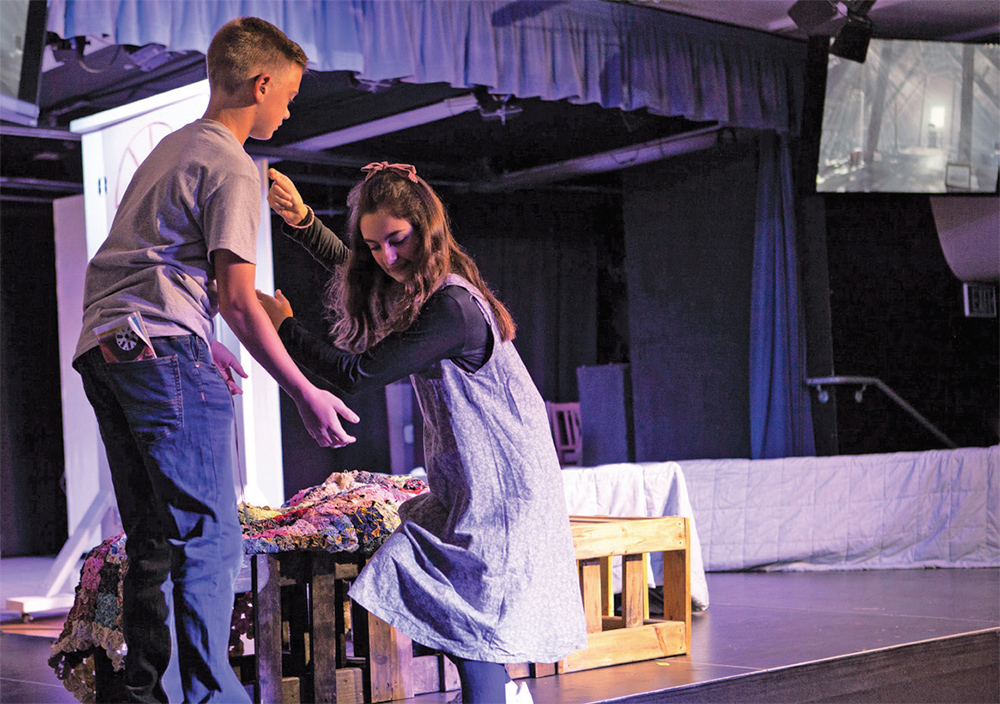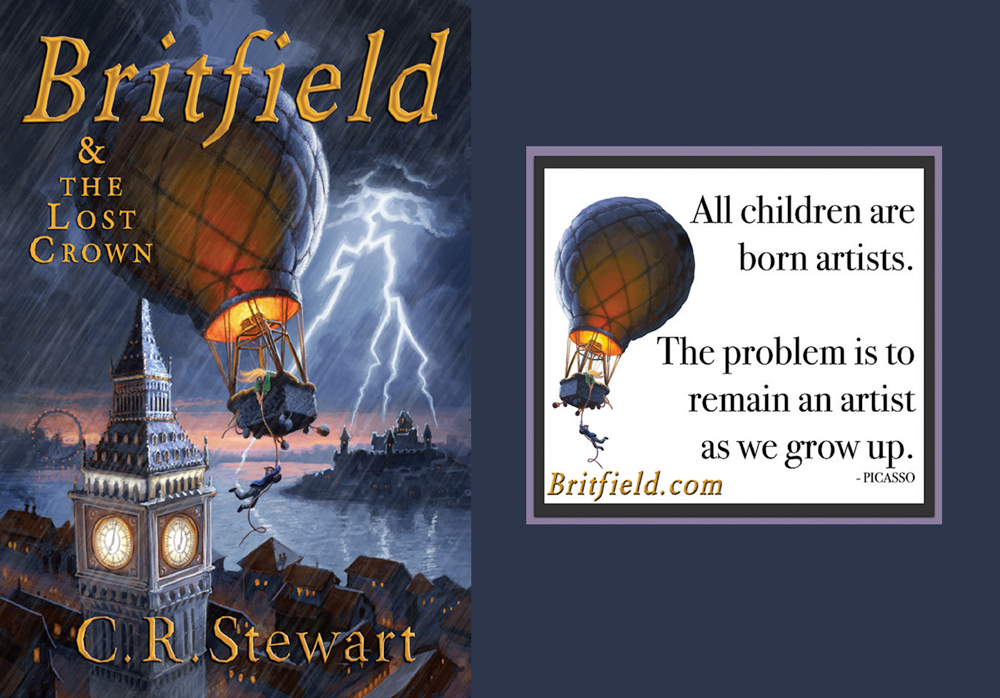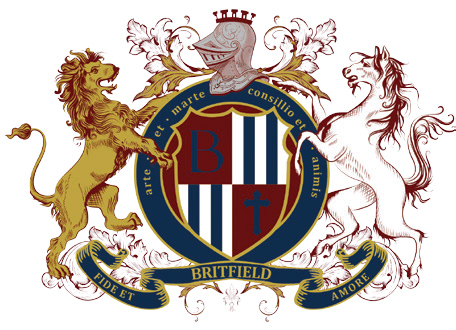

In “Britfield & the Lost Crown,” the first release of the Britfield series, protagonist Tom and his 55 fellow castaway children live at an orphanage in Yorkshire, England, where they are held captive. At the Weatherly orphanage, children live by harsh, standardized rules and even the slightest deviation is punished. They are known and called out by their number, not their name. The rulers of this corrupt system drive the children to relentlessly perform duties in their outworn factory, making them rich, while there is little-to-no food or decent clothing for their charges.
Twelve-year-old Tom and the other orphans have become a family and they look out for each other. They have courageously devised workarounds to help survive the brutal environment and their evil minders. There is little joy or imagination inside their walls.
The only way to access the outside world is a high-risk dash to the rooftop for a wonderous view of the beautiful English countryside. And the orphan’s only possibility for personal enlightenment and entertainment is to read books, yet they have none. So, they create a clever system to “borrow” books from the owner’s home library, a task that requires a successful escape from one building to another and back again—enduring monumental risk and a vicious canine.
Tom is caught on one of his book-borrowing missions, and during an interrogation he is inadvertently told his parents are still alive. A series of events that follows this shocking news leads Tom, and his best friend at the orphanage Sarah, to face the moment of truth—that they must escape and search to find them.
Thus begins the fast-paced, adventurous, and action-packed Britfield series that engages readers with real world iconic monuments, historic places, mystery and intrigue, bad people, and the unexpected kindness of strangers who support them along the way.
One of the surprises of “Britfield & the Lost Crown” is that while the orphanage conjures up a mid-1800s Charles Dickens era, the story of Tom and Sarah is set in modern times. Author C. R. (Chad) Stewart is a fan of Dickens’ works and was heavily influenced by him and several other British novelists. Influences not found in Britfield are today’s trending storylines that feature dark and post-apocalyptic worlds, sorcery and spells, witchcraft, the occult, and the illicit or other topics found in stories such as “The Hunger Games,” where children kill each other to earn food or for entertainment in their dystopian world.
“There is an 80% gap worldwide in the market for family-focused, clean, fun, and adventurous educational stories,” Stewart said. “There’s little-to-no competition for us. You cannot produce enough quality content right now for this market. Think of the Hardy Boys series that was first published in 1927. Or Nancy Drew. Go to the Young Adult section at Barnes & Noble and see what’s there. It’s mostly witchcraft, superheroes, occultism, and fantasy,” he said. Additionally, Stewart has researched and documented that children’s greatest thought influences today are 86% from media, 12% through school, and a marginal 2% at home, from family. He further documents the shocking statistics of what a child sees in media daily—excessively repeated amounts of explicit, violent, and other negative material.
Stewart wanted his characters to be relatable to middle-school readers, and for them to solve their problems using common sense and good judgment while placed in actual settings, such as London in “Britfield & the Lost Crown.” There is no hidden agenda, offensive content, or undermining principles in his books.
Britfield is often classified in the adventure fiction genre, and Stewart has realized the massive global potential for his work and the ability to fill the gap. His young readers tell him—face to face during school tours—that his one-of-a-kind book doesn’t remind them of anything else they’ve ever read. And they are right. The unique combination of adventure, history, geography, creativity, great characters, and masterful, layered storytelling is Stewart’s brand. As a professionally trained screenwriter, Stewart is often complimented on the fast, action-filled pace of his writing style, one that some say reads like the flowing scenes in a movie. Soon, fans can look forward to Britfield movies, based on the books, that are in development now.

Stewart has practically invented a new literary genre, one that intentionally lives at the intersection of literature and education, and that first-of-its-kind vision and market strategy firmly places him in a category of one. It’s one thing to create content—books, movies, and plays—for arts’ sake, or commercial profit. Instead, Stewart is propelled by a keen awareness that school children start to lose their creativity at an early age based on how the education system is designed. Some even say that schools, and movements like “No Child Left Behind,” are driving the love of learning out of children and replacing it with protocols that reward the hard work of memorization and test-taking achievement, focusing on conformity over creativity.
No other author that we know of takes Stewart’s approach of actively partnering with his young audiences, as he does through the Britfield National Book Tours. Stewart traveled 9,000 miles through 23 states and presented his book at over 200 schools to more than 40,000 students. “I visited every kind of school, from the top-tier private schools to Title 1 Schools in Dallas,” he said. “Our focus is on fourth through seventh graders who are still excited, creative, and you can plant seeds in them that will stay with them for the rest of their lives.”
Once his first manuscript was completed, he handed his book over to more than one hundred school children who read it and took notes. “The fact that they read the whole book, nearly 400 pages, with all they have on their plates, was a good sign,” Stewart said of his youthful editors. Their insightful feedback was incorporated into the manuscript. Stewart is passionate about instilling a love of creativity and curiosity in his audience.
Research shows that automation and artificial intelligence are replacing an alarming number of jobs in corporate America now and more so in the coming years. A McKinsey study shows that AI and machine learning-enabled tech could replace up to 30% of the jobs in the workforce by 2030. Combine that with the fact that the people feeding into the workforce and facing this technical tsunami aren’t fully prepared to compete and excel, and you have a problem. What’s sorely lacking in the job force is now cited as the number one most-desired and needed job and leadership skill, and that is creativity. That is why executives take improv classes. To keep their mental dexterity strong and to think abstractly on their feet.
The World Economic Forum’s Future of Jobs Report says that creativity and innovation are the most valuable skills people will need to stay relevant and to thrive in accelerating change. Creativity is a must for job seekers, but also will be a challenge for those who hire and manage—they must too be able to embrace new ideas and new ways of solving problems with a more creative workforce.
The Britfield Institute is the non-profit programming arm of the Britfield Dynasty. In addition to donating its books to underserved school communities, the three-phase program is designed to encourage students to transform their ideas into real innovations and products, such as a book, website, service, or business. Phase One introduces interactive presentations to foster children’s curiosity and creativity. Phase Two will offer workshops and classes on idea cultivation. And in Phase Three, the Institute team will choose unique and innovative ideas from students and provide mentoring and financial support for the development of those ideas.
Tom and Sarah will be busy in the years ahead. As Stewart’s appointed messengers, they will bring the valuable skills of creativity, literacy, and entrepreneurship back into schools, classrooms, and living rooms with the hopes of instilling greater faith in literature for their young audience. “Most children are highly gifted if they are given the proper opportunities and support,” Stewart said.
The hot air balloon scene in the book, and shown on the cover of “Britfield & the Lost Crown,” is an apt metaphor for Stewart’s expansive vision. He is lifting people up.
. . . . . . . . .
Quintessential Media Group founder Lisa Stamos is the publisher of Quintessential Barrington magazine in Barrington, Illinois. She may be reached at lisa@qbarrington.com. Learn more about Britfield at britfield.com.

Britfield is more than a book, it is a movement in literature, literacy, and creativity, bringing encouragement to children and families worldwide. It is a 7-books series, followed by seven major motion pictures, with the first movie in development. Book I takes place in England, Book II in France, Book III in Italy, and then around the world to end up in America, with Book VII. The Britfield characters mature by one year in every book: Book I (12 years old), Book II (13 years old), Book III (14 years old), allowing the movement to engage middle schoolers while attracting the young adult audience (starting at 12 and ending at 18).

Gold Metals: Parents’ Choice Awards, Book & Audiobook • Gold Medal: Children’s Literary Classics International Book Awards, Middle Grade Chapter Book • Gold Medal: Mom’s Choice Awards, Best in Family Friendly Media • First Place: Purple Dragonfly Book Award, Middle Grade Fiction • First Place: CIPA EVVY Awards, Juvenile Fiction • Winner: Book Excellence Awards, Pre-Teen Fiction • Winner: American Fiction Awards, Best Cover Design • IndieB.R.A.G Medallion: Award-Winning Middle Grade Books • Silver Medal: Moonbeam Children’s Book Awards, Preteen Fiction • Silver Medal: Global Ebook Awards, Children’s Literary Fiction • Second Place: Reader Views Readers Choice Awards, Teens • Bronze Medal: The Wishing Shelf Book Awards UK, Fiction Ages 9-12 • Award-Winning Finalist: International Book Awards, Children’s Fiction • Award-Winning Finalist: American Fiction Awards, Pre-Teen Fiction • Award-Winning Finalist: Best Book Awards, Children’s Fiction • Award-Winning Semi-Finalist: CIBA Gertrude Warner Book Award, Middle Grade Fiction • Award-Winning Long List: Shelf Unbound Magazine, Best Indie Book • Blue Ribbons: Old Schoolhouse Magazine, Favorite MG & YA Book and Teen’s Choice Award
Share this Story